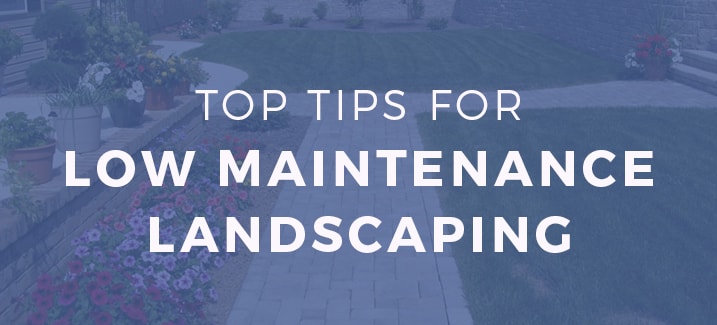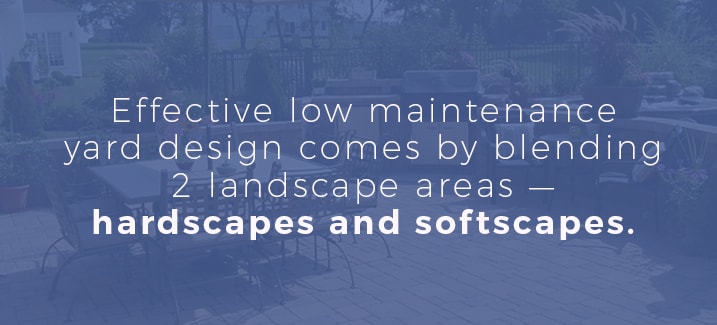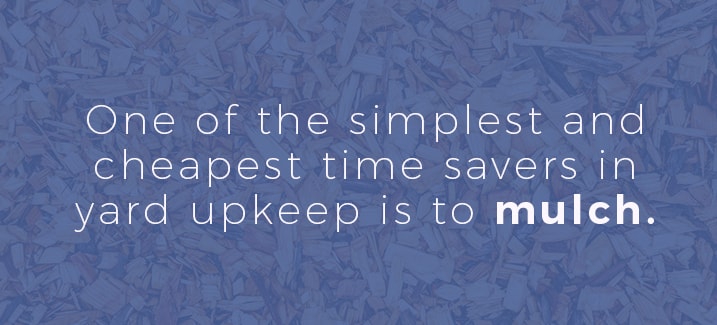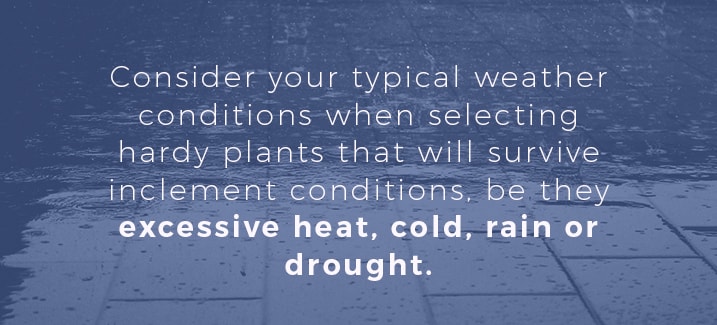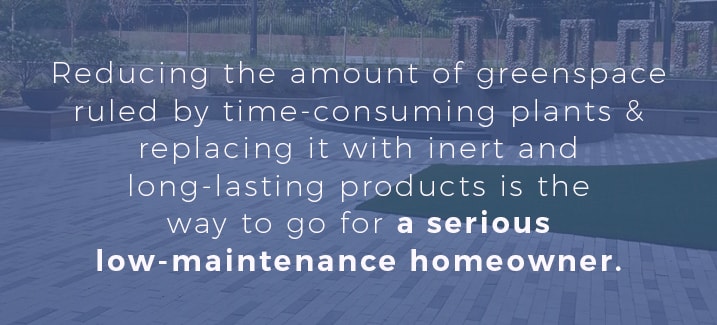We’ve all heard the expression, “less is more”. It’s a phrase often overused, but nowhere does it apply better than to having low-maintenance landscaping. Less maintenance, especially in landscaping, is more time available to do other things, like enjoying those outdoor spaces.
Your outdoor living spaces are an extension of your lifestyle. Just as the inside of your home requires maintenance, so does the outside. Interiors are a constant cycle of washing, vacuuming, dusting and cleaning of all sorts. No one strives to increase interior maintenance, so it goes without saying the same applies to a home’s exterior.
There’s more to exterior home maintenance than window washing and the occasional painting. Most of today’s homes are built using low-maintenance materials like stucco finishes, vinyl sidings and long-lasting roof shingles. In fact, many homes have absolutely no exterior claddings or accents that ever need painting, and all that’s required to keep them looking fresh is the occasional hit from the hose. Even homes that use architectural block or veneers require minimal upkeep.
Once you move away from the exterior walls, though, the maintenance game changes considerably. Blending inert, manufactured products like those that make up a house into nature’s active domain presents all sorts of upkeep issues. There’s the driveway to shovel or wash, plants to be tended, beds to be mulched, trees to be pruned and of course, the inevitable lawn to be mowed.
There’re always outdoor yard projects to be built and looked after. It might be an unused area of the yard yet to be claimed, a patio to be constructed, storage buildings to erect or even a fence to put up. Achieving low maintenance outdoor spaces requires proper planning. Incorporating low maintenance landscape design with low maintenance landscaping ideas requires considerable thought and some knowledge of the many natural and manufactured products available.
Effective low maintenance yard design comes by blending two landscape areas — hardscapes and softscapes. Hardscapes refer to the permanent fixtures like driveways, walks, retaining walls and patio surfaces. Given proper selection, these hardscape surfaces present low or almost no maintenance. Softscapes, on the other hand, can be terribly time-consuming if not planned or if left without ongoing maintenance, including having the various tools and maintenance equipment available to make the job easier.
Landscape maintenance may be more than many homeowners can keep up. Aging retirees may find they can no longer keep up with the physical activity necessary to keep their yard maintained. Younger professionals may not have the time and the cost of excessive maintenance is more than they have money for.
It doesn’t have to be so. Maintaining a yard doesn’t have to be an unnecessary burden for the young or the old. By starting early and planning a low maintenance landscape design, all homeowners can save a lot of time and money by doing it right the first time or giving their yard a makeover with some of these low maintenance landscaping ideas.
Ditch the Grass
Remember, less is more. Less grass gives you more time to relax and enjoy the yard or any one of a hundred things you could be doing rather than mowing the lawn. That includes watering the lawn, fertilizing it and raking up fallen debris.
Again, less is more. Less grass equals more money you must spend on other things. Consider the expense that an expansive crop of grass consumes. Maintenance on a lawn includes the water bill, costs for fertilizer, buying lawn tools like edgers, aerators and rakes. It also includes the cost of a mower, the fuel and the maintenance those lawn tools take.
There’s no real rule of thumb in planning lawn area. So much of planning depends on your needs, such as kids and dogs who need lawn space to play or seniors who just want to sit on the patio and enjoying the looks and smells of shrubs, beds and flowering trees. Many homeowners go for no more than 50 percent lawn area as part of their softscape design with beds, hedges, trees and containers taking up the other half.
No discussion about lawn maintenance comes without addressing water. Overwatering is a maintenance thief in time and money. Most urban areas have a metered water supply that can be very expensive. Cutting down on area reduces watering, which saves on time. Here are a few tips in controlling lawn maintenance:
- Limit Fertilizer — Excessive fertilizer makes a lawn grow quickly, which requires more water and cutting. Once in the spring and once in the fall is sufficient.
- Mow High — Cutting only the top third of the blade limits growth, keeps weeds down and requires less water.
- Use a Rain Gauge — Rain gauges are useful for monitoring how much rainfall you lawn has received. Grass naturally roots itself to the area’s rainfall. Only water when needed.
- Install an Irrigation System — Not only will you use less time in servicing the grass, you’ll pay for less water.
- Install a Timer — Watering early in the morning allows less evaporation and more water to soak to the roots. No need to get up at 5 a.m. when the system will automatically start up.
- Mulch Grass Clippings — Leave your grass clippings on the lawn to mulch. This won’t just save you time, the mulch will shelter the grass, let it need less water and protect it against invasive weeds.
Much Mulch
One of the simplest and cheapest time savers in yard upkeep is to mulch. This isn’t just a low maintenance landscaping idea for the lawn. It applies to garden beds, raised planters and around the bases of trees.
Mulching covers the soil and keeps it cooler, conserving moisture. Also, proper mulching is the most effective device you can have for weed control. Not only is the soil protected from weed germination, the PH level in mulch, especially composting mulch, is usually too high for weeds to blossom yet mulch has no detrimental effect on plants that are already established.
Many homeowners use compost for mulch as part of their low maintenance landscaping ideas. Compost is simply the decomposing remnants of past plants, tree prunings and yes, lawn clippings. Compost that turns a nice, black hue adds a rich look to garden beds while keeping weeds and water controlled.
You can also buy mulch from any garden supply, and commercially available mulch is usually sterilized to guard against evasive seeds. Tree bark, such as pine straw or chipped cedar, is popular and very effective at weed and water control. A 3-inch mulch topping is considered adequate. Too much mulch, though, can be smothering for the plants by not allowing enough oxygen to the roots. “Less is more” also applies to mulch.
Proper mulching is a low maintenance trick used by savvy gardeners, not just by time-strapped homeowners. Changing mulch is only needed twice a year, usually spring and fall. Another low maintenance landscaping trick is in picking the proper plantings that are long lasting naturally easy to care for.
Pick Your Plantings
The best advice for low maintenance outdoor plants and flowers is to use proven survivors for your area. The second best advice is to group the proper plants according to their watering requirements.
There’s a tremendous amount of information about low-maintenance plants available. The internet is a good source and so are gardening books and magazines. Green-thumb neighbors are also a good well for advice, not to mention possibly offering some cuttings, seeds or shoots to get you going. Perhaps nothing is better, though, than a visit to a local, reputable nursery. The staff there will recommend the best plants to keep you out of time-trouble.
Plantings are broken into five main groups, each with their own maintenance issues. The challenge is in knowing what each group offers, what their requirements are and which ones are best suited to a particular location in your yard. Here’s a brief look at the planting groups:
- Trees are the anchors in every landscape. Primarily, trees are either deciduous or evergreen. Deciduous trees lose their leaves every fall and grow new ones in the spring. Leaf raking can be a chore, particularly for anyone whose mobility is restricted. Raking is ongoing in the fall, however, dead leaves are great for recycling into compost. Evergreens keep their needles year-round, but some have a nasty habit of shedding needles and dropping cones that need cleaning up.
- Shrubs are like mini-trees and come in both evergreen and deciduous varieties. Once mature, shrubs can occupy a large amount of space in a properly designed landscape plan and deliver a great return on beauty for limited care. Generally, shrubs require the occasional trim as in a hedge and, like trees, require almost no watering once their roots are set.
- We’ve covered this one. The trick with grass — less is more.
- Perennial plants are also permanent partners to a low maintenance yard design. They regrow year after year, dying off in the fall and coming back in the spring, delivering a brilliant show of color in their leaves and flowers. Because perennials have well-established root systems, they require little watering and are the perfect choice in giving a great show for limited attention.
- Annual plants require a new start each year and reproduce from seeds. Annuals can be incredibly showy, but are finicky creatures when not carefully attended. With fragile root systems and a steady demand for water, annuals are the highest maintenance plants in a landscape. They’re best used in containers and hanging baskets, although many gardeners use annuals as front-line showpieces in flowerbeds.
We just mentioned creatures. Low maintenance landscaping design always takes into account nature’s mobile partners who can present an ongoing and time-consuming battle. Pest control isn’t just for country folk. Deer are urban dwellers as well, and if you plant roses, you’ll be feeding them.
Insects, whether they walk, fly or crawl can devastate a beautifully landscaped yard if you select the wrong plant species and an infestation arrives. Beetles, butterflies and blackworms all need to eat and what you decide to put on display may come right back to bite you. The best source of protection against fighting a losing maintenance war is to do your homework and identify hardy, low maintenance and creature-resistant plantings.
Weather is a huge factor in developing a low maintenance landscape design. The sun, shade and wind patterns are fixed commodities and need to be worked into the overall hardscape and softscape plan. You can easily avoid damage to fixtures and plantings with a little thought to the founding materials used in a low maintenance yard design.
The area you’re living in is also a contributor to controlling unnecessary maintenance. You need to consider it when selecting hardy plantings that are going to survive inclement conditions, be they excessive heat, cold, rain or drought. Check your USDA Hardiness Zone, then select plantings compatible with your climate.
Soil Testing
An often-overlooked part of landscaping maintenance is performing yearly tests on your soil. This is not just for the garden beds. It’s for containers, lawns and the base of trees as well. You can buy soil-testing kits at most landscape suppliers or you can take samples in for professional testing.
Soils that are too high or too low in PH will cause plants to be weak and straggly contributing to unnecessary, costly and time-consuming efforts to maintain their health when the problem starts right in the soil.
Lack of nutrients in the soil is another leading cause of plant illness. Nutrients such as nitrogen, potassium and phosphorous, as well as trace elements, don’t necessarily have to come from commercial chemicals. Well-composted vegetation naturally produces these basic requirements for plant health. When introduced to the soil through mulching or mixing, the natural process of nature’s breakdown may be all that’s necessary to keep plant health high and maintenance low.
Watering
Deep, periodic watering is far more effective than short, daily watering for keeping landscape maintenance low. Frequent, shallow watering doesn’t force plants to send their roots down far enough to survive a drought period. Even a short space without water can then send these watering-dependent plants into shock, possibly killing them.
Watering doesn’t have to be a laborious, time-eating process thanks to the multitude of watering aids available today. They include:
- Entire piped irrigation systems throughout the entire landscape plan.
- Timers to automatically activate and deactivate a system.
- Zoning to control what gets watered and when.
- Soaker hoses to release water slowly and continually.
- Dribblers to ensure correct amounts of water go to each plant.
There are a host of other devices out there to cut down on watering time and the amount of water used. Check out bubblers, microsprinklers and water-conserving crystals that look like little Jello blobs. Setting these in with plants will reduce your watering time by half.
Increased Living Space from Hardscapes
Reducing the amount of greenspace ruled by time-consuming plants and replacing it with inert and long-lasting products is the way to go for a serious low-maintenance homeowner.
Many people are filling in natural areas with stunning-looking and incredibly durable manufactured products like bricks, paving stones, patio pavers, block retaining walls, cultured stone, crushed stone, solid edgings, outdoor tile, and good old concrete.
These practical masonry products aren’t just the first choice for landscape architects as they plan their low maintenance projects. They’re widely available and surprisingly affordable alternatives to time-robbing grass and beds filled with annuals, perennials, shrubs, and gobs of green.
Whether you plan to save precious maintenance time and money by extending your outdoor living space with a new patio, change the slope of your yard with a retaining wall or build the king of all outdoor barbecues, Nitterhouse Masonry Products has a wide array of hardscape materials to choose from.
Do yourself a favor. Take some time away from your landscape maintenance and visit Nitterhouse Masonry. See how Nitterhouse Masonry hardscape products can extend your outdoor living space and take less of your time in looking after.


